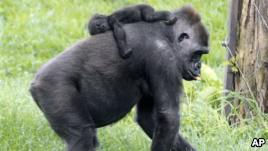保护非洲猩猩的计划

A new action plan has been open to protect Central Africa’s gorillas and chimpanzees. It outlines threats to the great apes(猿) across six countries.
The regional action plan is a joint effort by the International Union for Conservation of Nature, Wildlife Conservation Society, and World Wildlife Fund among others.
Dr. Fiona Maisels, a conservation scientist for the Wildlife Conservation Society, said the plan aims to protect the large number of great apes not in protected areas.
Maisels said the chimpanzees are eating better than the gorillas in Central Africa. But both are threatened by hunting, habitat loss and disease. The nearly 80 percent of great apes outside protected zones, are in areas where private extractive industries (天然生产业)operate. Maisels said African nations need private industry’s help in saving the great apes.
The Regional Action Plan for the Conservation of Western Lowland Gorillas and Central Chimpanzees also highlights another big threat – Ebola(埃博拉病毒).
“We lost thousands and thousands of great apes along the Gabon-Congo border about 10 years ago with a massive Ebola epidemic(流行病)," Maisels said. "Nothing like as big as the one we’ve seen in West Africa. And it wiped out huge areas of gorillas and chimps in the forest before it got into the villages. The only reason we knew about it was because people started getting sick. And that’s because they were finding dead animals in the forest – picking them up – taking them home and eating them. And then of course it went through villages just it’s done in West Africa.”
Maisels added that current Ebola vaccine (疫苗)research could lead to protection for humans and apes alike.
The previous action plan was released in 2005 and is successful in slowing the decline in ape populations.
本时文内容由奇速英语国际教育研究院原创编写,禁止复制和任何商业用途,版权所有,侵权必究!